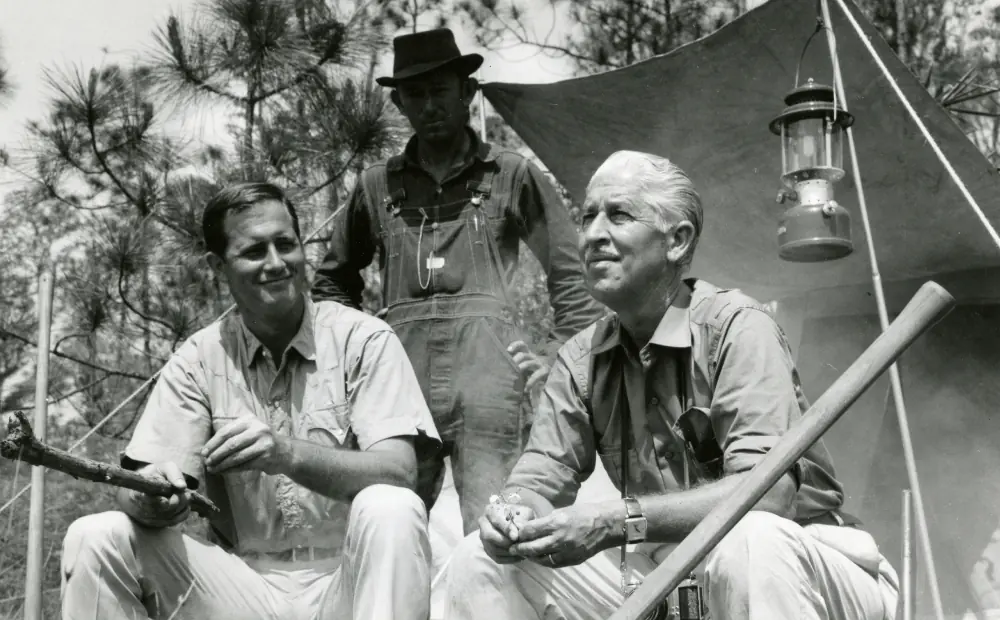0:00
Traveling throughout North America and sharing inspirational stories of conservation, Peter and I constantly encounter incredible wildlife.
0:09
You are kidding me.
0:12
Both large and small.
0:14
Wasn't that long ago you were emerging from an egg?
0:18
That's right.
0:19
These moments are always magical and often unexpected.
0:25
Oh, my goodness.
0:26
A mother and a baby.
0:27
Yeah.
0:28
Today, we're on a journey to encounter animals in their natural habitats.
0:36
We begin today's journey on the Texas Gulf Coast.
0:40
Elsao's ranch has been a working cattle ranch for more than 150 years.
0:47
It's also home to some pretty impressive wildlife, from ocelots to antelope.
0:54
James Powell is showing me around.
0:57
So I honestly didn't expect to see things here in South Texas.
1:00
So rush and breathe.
1:02
It's beautiful.
1:03
This is the perfect time of year to come and visit us.
1:05
Everything is blooming, blossoming.
1:08
Elsaus is home to three ecosystems found in South Texas coastal sand plains, Gulf marshes and scrub country, which is where we are now.
1:18
Now, these look like wildlife trails through here.
1:21
It is.
1:22
You can picture an ocelot coming through this pretty easily.
1:25
They're low to the ground.
1:26
They're snaking their way through.
1:28
But what you'll see also, whitetail deer, no guy antelope, all those other big mammals just working their way through this stuff.
1:36
We'd be caught up on everything and struggling, and they just ghost through these trees.
1:40
It's amazing.
1:42
Hey, look at that.
1:43
That's a Texas tortoise.
1:44
Texas tortoise.
1:45
That's a Texas tortoise.
1:46
And this is about full growth.
1:47
Yeah, that's that's an adult.
1:49
They are not an endangered species, but they are state threatened.
1:55
Unlike their desert tortoise relatives across the Southwest, the Texas tortoise doesn't typically dig Burrows.
2:02
They find shelter in the cool shadows of this thick vegetation, exploring all sales.
2:11
Ranch is amazing, but it's also best to keep your eyes and ears on high alert.
2:18
Oh, wait, wait.
2:19
Hold on a minute.
2:19
Look at this.
2:20
This is a Western Diamondback.
2:23
And this is.
2:23
This looks like an adult western.
2:25
This is an adult.
2:26
He's not a he's not a super large one.
2:30
Seems to know where we are.
2:31
Yeah, he knows where we are for sure.
2:34
Yeah.
2:34
So he's basically sensing our heat.
2:37
He knows we're a large, warm object.
2:40
They're a lot more scared of us than we are of them.
2:43
So historically, people fear snakes.
2:46
The first thing they want to do is kill them, and they're afraid of them.
2:48
They don't understand them.
2:49
Why are they so important?
2:51
If they weren't here eating the things that they eat, that could throw the entire ecology of this area out of balance.
2:59
I agree.
3:00
So I think we're doing the right thing.
3:01
We've observed him.
3:02
We appreciate him.
3:03
He's a magnificent looking snake.
3:05
And now we'll let him go on about his way.
3:06
We let him go do his thing and we'll go do ours and.
3:09
And hopefully not cross paths accidentally.
3:12
Absolutely.
3:13
Yeah.
3:14
Our rattlesnake encounter was unplanned.
3:17
But other wild animal encounters are carefully prepared and carried out by professionals here in the remote mountains of New Hampshire.
3:24
We're about to come face to face with a mother black bear and her Cubs.
3:29
Black bears were nearly wiped out across New England just a few decades ago.
3:34
Now the wild population is making a comeback, thanks in part to the New Hampshire Department of Fish and Game.
3:40
Right now, the biologists here are preparing the sedative that we'll use to tranquilize the mother bear.
3:47
They've been monitoring the location of the mother bear for several months using radio telemetry.
3:52
It's the same technology we highlighted on Wild Kingdom over 40 years ago.
3:59
Wildlife biologists have been putting radio telemetry collars on bears in recent years to track them in their habitat.
4:06
The collars send out radio signals that can be picked up by the antenna as far as 5 miles away.
4:14
It is necessary to change the batteries in these collars each year.
4:18
The easiest time to do this is in the winter when the black bear is in her den, has delivered her Cubs and the new little family is hibernating.
4:30
We got the mother bear anesthetized.
4:33
I can already see a little cub.
4:34
It's like a light kind of a grayish color.
4:37
I got to get in there checking on bears in their hibernation dens.
4:42
It's something I've done many times in my work as a wildlife ecologist.
4:46
But I got to say it never gets old.
4:50
OK, we've got 2.
4:53
We've got two.
4:54
Hello.
4:55
And we've got, we have three newborn Cubs to this Mama.
5:02
I'm going to pass them off to some of our crew to keep them warm.
5:05
They are too little to thermoregulate right now, which means they cannot produce their own body heat.
5:10
They need their mother's body heat or a volunteer to keep them warm.
5:16
Welcome to motherhood.
5:18
This is science, but it's also magical.












